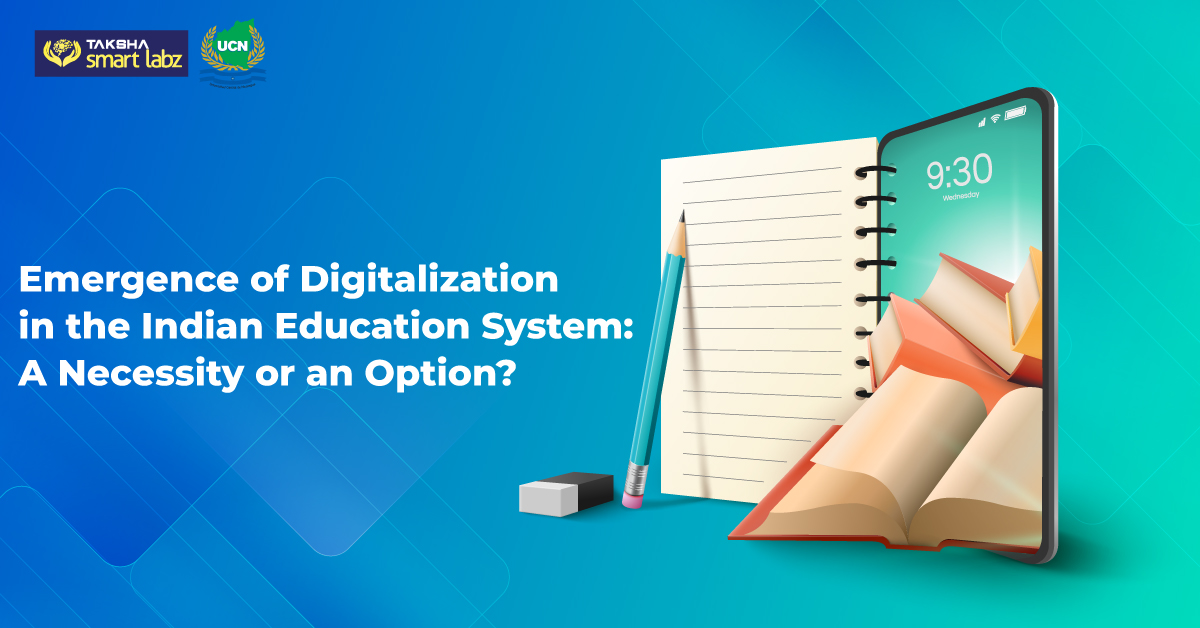Blog Summary
The COVID-19 global pandemic has considerably increased awareness of the value of digital learning. Even regular classes are being conducted virtually for their standard pupils as a result of it. They use technology-assisted learning tools as platforms to carry on providing educational services online. Due to the user-friendliness of all digital gadgets and e-learning portals, students of this generation have no trouble comprehending or utilizing them. Awareness and aptitude are crucial for such digitalization to be implemented and succeed. Education will be accessible to everyone, regardless of circumstance, thanks to digitalization. The Indian educational system will undergo a fresh iteration of digitalization. The main drivers of this trend are affordable high-speed internet and the availability of digital devices.
Online learning has overtaken its traditional counterpart. Digital learning transcends national boundaries and makes the continuation of learning possible, especially during unprecedented and undeterminable situations like the COVID-19 shutdown.
The effectiveness of digital learning has significantly been realized during the global pandemic, COVID-19. It has made even regular classes go online and conduct virtual classes for their regular students. Technology-aided learning tools become mediums for them to continue their educational services digitally. COVID-19 may have distanced students and teachers socially, but digital devices have brought them together and paved the way for a seamless, collaborative learning experience.
While countries are struggling to combat the spread of this deadly virus, educational institutions are an urge to engage their students in all possible means. It is appreciable that most of the institutions have acted fast and adopted digital platforms to foster access to education. However, is that effective? And, how is the response from the students, teachers, and parents?
The concept of online learning has been there in existence for a long. However, it was not often considered as the primary mode, pushed to secondary consideration, and considered inefficient.
Adoption of Digitalization by Educational Institutions
After digitalization, life becomes easier. From tax to taxi, we can get things done in a few taps. How effective will it be when it comes to education?
The advancement in the digital world has brought tremendous changes in almost all industries. The educational sector is no exception. Digital innovations have touched education more productively and taken it to the next level.
Now, the educational sector has taken advantage of this digitalization by implementing a range of learning applications, digital platforms and e-learning portals, interactive game-based learning, virtual classrooms, and so on. This emerging trend has transformed the conservative idea of learning and favored both students as well as educational institutions.
Unlike classroom learning, digital platforms make learning more participative. It helps students involve in activities that can be reviewed by the teachers/instructors in real-time. The overall learning experience has been increased with the advent of digital devices and applications that simplify education.
Moreover, online resources can be used in plenty of ways and repurposed. Such valuable and informative resources can be shared across and kept for generations. It also allows the teachers to customize the resources and assessments based on the needs and abilities of the individual students.
Trending Digital Technologies for Enhanced Digital Learning
Technology has reached the nook and corner of India. Everyone has access to the internet and various technologies, either it is for learning or business. Awareness and ability play a major role in the implementation and success of such digitalization. In that case, students of this generation do not find any difficulty in understanding or using the digital devices and the e-learning portals as they are all made to be user-friendly.
Digital devices like smartphones, tablets, laptops, and computers have imparted the traditional way of education to advanced learning platforms where the students can learn with ease. Education is one of the most competitive sectors. Students can take up a course of their interest if they are equally competitive. Digitalization will make education available for all as it crosses borders irrespective of the situation.
While there are plenty of methods available, here are a few that have been considered efficient:
- Learning Management System
The learning management system is used for conducting online courses. Here, the learning materials will be available all the time for students to have at their convenience. However, they may have to follow the methodologies set by the course providers.
- Virtual Classrooms
This method is effective when a course needs a direct interaction between students and the teacher. As they do in the real-time classroom, virtual classroom requires the participation of both of them. Here, they connect online on the e-learning portal. Many educational institutions have utilized this method during the COVID-19 to instruct and engage their students.
- Gamification
In recent years, we have witnessed a range of learning applications emerging in the educational industry. They have been proved effective in making students learning their subjects and concepts in an interesting way of gamification. Such platforms are made to be interactive that makes learning fun for students and easy for teachers and parents.
Setbacks in This Revolutionary Education Concept
When there are positive aspects, there will always be negative sides.
- Lack of Monitoring
Monitoring students’ progress in the learning curve is possible only through assessments. Real-time monitoring of student attentiveness and understanding is not possible. Thus, online learning can be effective only if the students are interested to learn and participate in the classes.
- Resource Theft
Learning materials are the base and important resource of digital education. Even advanced technologies cannot prevent resource thefts that are happening across various digital platforms.
- Cyber Security
Cybercrimes are happening everywhere. E-learning platforms cannot escape from it. Digital learning platforms are also vulnerable to plenty of cyber threats.
- Regulations
As per the regulations of the UGC, not all institutions can give online learning courses. The course can be offered online only if it is accredited by the NAAC with a minimum score of 3.26 on a 4-point scale and must be 5-year old. This creates a lag in implementing digital learning.
All these setbacks can be addressed if technologies are implemented and streamlined. Either it is a technology or other resources, it must be used with precautionary notes for an effective outcome. Otherwise, it would go the other way.
Will Digital Learning Become the Future of Education in India?
Digitalization is going to take a new incarnation in the education system of India. It is undoubtedly an important phase as educational institutions are started to adhere to the new concept of digital learning. It has changed the overall framework of education. It eases the way of teaching and learning through responsive resources, user-friendly learning modules, self-learning methodologies, and interactive sessions.
Besides, searching and assessing a learning resource online is easy and time-saving. It makes many consider e-learning as a better option. The penetration of such digitalization is emerging at a faster pace in India. Accessibility of digital devices and affordability of high-speed internet are the major reasons for the emergence of digital technology in the Indian education system.
When we speak about online learning, it does involve not only the school/colleges/universities but also general information. Such information may be required for students to learn some skills of their interest or get additional information about their curriculum.
Besides, not every town of India is advanced in education; a few are still in dismal, mainly rural areas. Students in rural areas could not access all resources and information that are being enjoyed by the students in the city. When education becomes digitalized and accessible, such students will get benefited.
Developing countries like India can take advantage of such an innovative idea of digitalizing education. Adopting this will benefit learners with a stream of resources and knowledge. It would be a digital revolution for having access to advanced information a few taps away.
Continuation of Digital Adaptation
Ingression of digitalization in the education sector is probably a cusp in history. Replacing the classroom-learning model with e-learning is not advisable. Certain professional courses like medicine have their core values that need practical demonstration and real-time learning. Therefore, it depends. However, the digital platform can be used as a backup during emergencies like COVID-19. Or, use it as an add-on facility to be used to improvise the learning capability of the students, respectively. Moving the entire education system to a digital platform will not be effective for all courses or for all students.










